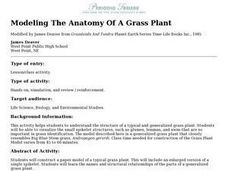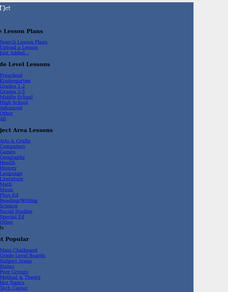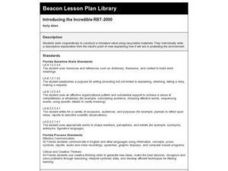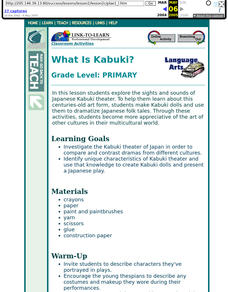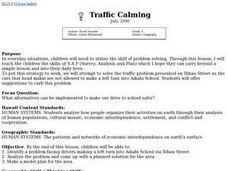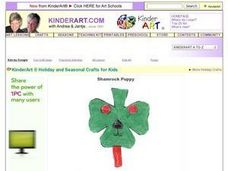Curated OER
Fireplace Logs from Newspapers
Learners discuss the topic of recycling. They identify items that can and cannot be recycled. They practice using their newspaper to make other items.
Curated OER
Drumming from the Heart
Students complete a craft activity using recyclable containers and read a story to a younger child. In this service lesson plan, students read the story 'The Drum' and do a service project retelling the story and making a drum from...
Curated OER
Rainsticks
Students create a rainstick decorated with repeated patterns of shape and color, out of paper towel tubes.
Curated OER
Reduce and Reuse
Students conduct a lunch waste audit by recording each item they throw away at lunch. They graph class lunch waste. They use this information to devise a plan of action to reduce lunch waste. There is also an activity to make paper.
Curated OER
Modeling The Anatomy Of A Grass Plant
High schoolers explore the structure of a typical and generalized grass plant. They visualize the structures of a grass plant by constructing a paper model. In addition, they identify the names and structural relationships of the parts...
Curated OER
Using Our Natural Resources Wisely
Young scholars understand how ground water can be recycled to maximize its usage and begin to think about ways conservation can help Kansas preserve its natural resources in other areas - soil, minerals, and clean air.
Curated OER
Acid Rain - Go Away
Students set up an experiment and make observations of the effect of acid rain.
Curated OER
Introducing the Incredible RBT-2000
Fourth graders construct a miniature robot using recyclable materials. They write a descriptive explanation from the robot's point of view explaining how it aid in protecting the environment.
Curated OER
Classroom Conservation
Fourth graders suggest ways paper and other natural resources can be used and recycled in the classroom. Students conduct a investigation into paper use and make distinctions among observations, conclusions (inferences), and predictions.
Curated OER
Watermelon, Watermelon
Students create watermelon slices using red construction paper, paints, and watermelon rinds in this excellent elementary lesson for the end of the school year. The class is also able to enjoy eating watermelon slices during the activity.
Curated OER
The Rotten Truth
Learners study the process of decomposition using lunch leftovers and soil. They complete the inquiry over set periods time as they observe the how composting takes place and finally, they sort the materials into biodegradable,...
Curated OER
Worms in a Bottle
Students gain a better understanding of the worm and its role in the recycling of organic materials into simpler forms by constructing worm bottles and observing for 60 to 90 days.
Curated OER
Traffic Calming
Third graders are introduced to the steps in solving a problem. Using traffic problems, they offer suggestions to solve this problem using the steps mentioned above. They also discuss what types of alternatives can be used to make the...
Curated OER
The Environment: Vocabulary
In this environment vocabulary worksheet, students complete 12 multiple choice questions, then translate a set of "environment words."
Curated OER
It's a Wrap!
Learners study two-dimensional and three-dimensional objects by assembling a sculptural piece from something very flat - pieces of newspaper or wallpaper. They see what materials people used to make clothing during the depression.
Curated OER
Shamrock Puppy
Students create small "Shamrock Puppies" using colored construction paper, crayons, and glue in this pre-Kindergarten lesson celebrating St. Patrick's Day. The lesson includes a resource link where printable patterns can be found.
Curated OER
Environmental Math Problems Grades 5-8
In this word problem worksheet, students solve 2 leveled word problems that are based on environmental issues. They work on problems that are leveled for grades 5 -8 and use concepts associated with money, percents, weight, and large...
Curated OER
Water Works
Students create a "water web" to illustrate the interdependence among water users and producers. They distinguish between direct and indirect uses of water; illustrate the interconnectedness of water users in a community; and demonstrate...
Curated OER
Pollution
Young ecologists investigate some of the many ways that human activities adversely affect the environment. After identifying the main types of pollution (air, water, soil), 3rd graders fill in a Venn Diagram by pasting cut-out pictures...
Curated OER
Maracas
Students create Maracas out of various supplies while learning about percussion instruments in this Art and Music lesson for the elementary and middle level classroom. Detailed directions for two different methods are given.
Curated OER
What's Outside the Window
What do your students see when they look outside the window? This project lets their imagination go wild, and lets you see what kind of daydreaming they do best. They each draw, paint, and color an image of what they imagine as they are...
Curated OER
Extra! Extra!
Young scholars describe how plants and animals depend on each other. They see how living and nonliving environments change over time. They identify ways in which humans have changed their environment and the effects of those changes.
Curated OER
A Tree is a Friend
Fifth graders discover the value of trees in our society. In this ecosystem instructional activity, 5th graders read the book, A Tree is Nice, and discuss with classmates how trees are essential to our existence due to creating...
The Imagination Factory
Design a Postage Stamp for Black History Month
Learners create a postage stamp for Black History Month. In this U.S. History lesson, students discuss the contributions of African-Americans and design a postage stamp to celebrate their impact.






